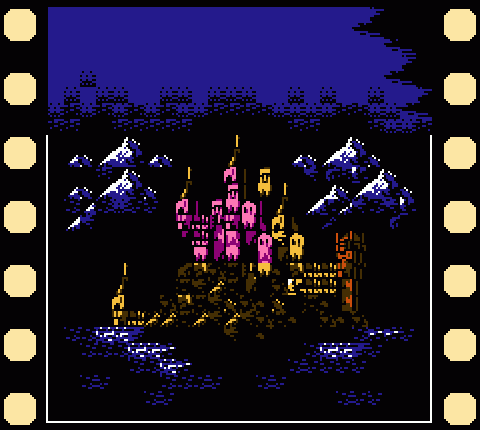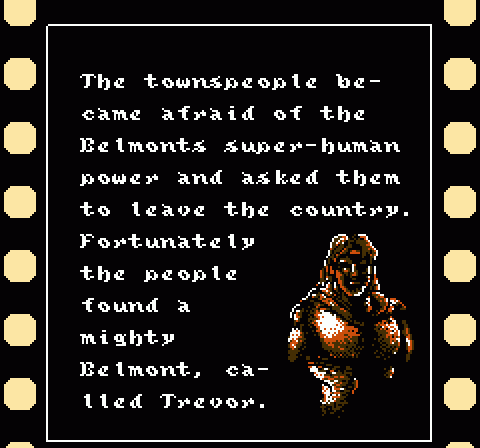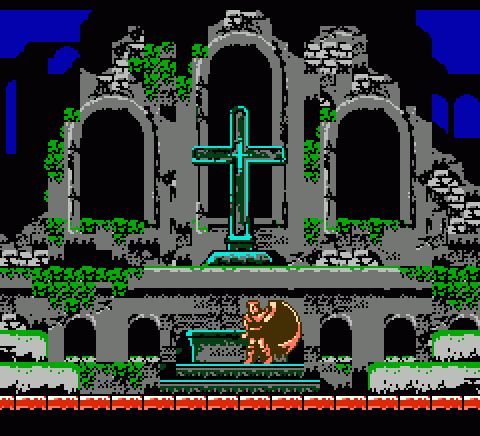
Many gamers see Castlevania III as a return to form, which is to say it turns the gears of game design backward to pretend Simon’s Quest never happened. Rather, it plays much more like the original Castlevania: Linear discrete stages, high difficulty level, stages designed as refined obstacle courses rather than meandering open spaces. New hero (ancestral Trevor Belmont) even looks almost exactly like Simon from the first game despite being a different character. The message here comes across clearly: We’re very sorry about Castlevania II, hope this makes up for it.
Personally, I found it very slightly disappointing at the time. What I’d really have liked to have seen would have been a Castlevania sequel that tied together the free-form style of Simon’s Quest with the more structured design of the original game rather than a game that essentially threw out of all the experimental ideas of the first sequel in favor of “Castlevania, but more awesome.” We wouldn’t see a game like that until Symphony of the Night—and, in fairness, maybe the skill and technology weren’t really in place for something on that level. Besides, what we did receive in the form of Dracula’s Curse was so good you can’t really take issue with it. And it’s not like every concept from Simon’s Quest was thrown to the wayside….

Konami’s crew wasted no time in making a declaration of their intentions with Dracula’s Curse. From the moment the title screen scrolls, its nature comes into clear focus: The monster movie metaphor of the original game (a trait of the series that would be lost after the NES era) plays a big part of the pre-game attract mode, as the backstory plays out matted against a frame of sprocket holes. “This is the sequel to Castlevania!” it declares. “Here we have the backstory to Simon Belmondo’s battle against Christopher Bee and Love Chaney, Jr.’s costumed monsters.”
The action begins with a name entry screen and password system—something lacking from the original Castlevania, and a sign that this game will indeed be larger and more complex than its antecedent. (There’s also a built-in cheat here: Enter “HELP ME” as your name and you’ll play with 10 lives per credit instead of three. You know, if you go in for those weaksauce shenanigans.) And, for the first time, you’re treated to a touch of context: Trevor prays for strength against the forces of evil at a shrine before dramatically rising and flinging aside his cloak to begin the adventure.

And the adventure begins in fine form. It’s the Castlevania style, alright, but the music is driving and powerful. The visuals are arresting. If Dracula’s Curse was indeed built on the “Castlevania but more awesome” premise, as we’re assuming, Block 1-01 through 1-03 lay it out for us quite neatly. The modest castle entrance of the original Castlevania and repetitive town backgrounds of Castlevania II are swept away in favor of the crumbling ruins of a city under siege. (According to Simon’s Quest’s layout of Transylvania, this town would be Yomi; Rondo of Blood, however, places Aljiba closest to the castle. I think the correct answer is, “Don’t think too hard about it.”)
The design thinking behind Dracula’s Curse clearly took its placement as the third game of a series and contemporary competition into account, because even the first set of sub-blocks manages to incorporate just about every hazard present in the first three full stages of the original game. The creators built this game specifically for fans of the series who were hungering for a challenge, and it wastes no time getting down to brass tacks. You’d have to try really hard to die in Blocks 01-03 of Castlevania, but I have witnessed a novice player who stomped the first boss of the 1986 original get a Game Over before reaching the end of Block 1-03.
But I think the game could afford to be tougher, because it launched into a more mature market than existed at the time of the series’ debut. Castlevania in many ways had to teach gamers how to play this style of game (whose only real antecedent was arguably Ghosts ‘N Goblins). By the time Dracula’s Curse arrived (at the end of 1989 in Japan, fall 1990 in the U.S.), console game design had advanced by tremendous strides. NES owners had seen the likes of Ninja Gaiden and Super C: True tests of skill and dexterity. The gloves could come off, the training wheels abandoned.
I remember the NP guides and stuff referring to the first town as “Warakiya,” which would be a wonky re-transliteration of “Wallachia” — the real-life region in modern-day Romania once ruled by Dracula. In fact, I’ve seen some timelines set this game near the end of Vlad the Impaler’s reign,.
Of course, this doesn’t quite work, since Wallachia is a *region* containing multiple cities-including Bucharest-not a city itself.
I remember being punished by Castlevania, the many times I rented it, then after someone lent me his copy I finished it. My play time with Simon’s Quest didn’t faired well, after the first time I rented it, I never touched it again, until I deemed myself to download a ROM and finish it.
Castlevania III was the first Castlevania I owned, and after finishing it, I anxiously expected the release Castlevania IV.
But my real Castlevania guilty pleasure is Bloodlines, which I find as a direct spin-off of Castlevania III.
It’s funny- I can’t get very far in Castlevania, but I nearly reached the end of Castlevania III.
As for towns, if the games tend to take place hundreds of years apart and they get burned to the ground whenever Dracula pokes his head out of his coffin, no reason both can’t be correct.
About time you got to this one! One thing I’ll be interested to hear about in a bit is whether the changes to Grant in the American version were good or bad for the overall design - Akumajou Densetsu Grant is pretty overpowered, after all.
You should comment about how in a ‘new game +’ or with codes you can take partners into the levels they normally wouldn’t
I was so sad when I first saw this game and it was nothing at all like Simon’s Quest. I loved the exploration of the landscape in 2, and as such didn’t play another castlevania till Symphony of the Night.
Shivam: I hear that. I think maybe games like this, Super Mario Bros. 2, and Zelda II were maybe a little ahead of their time as sequels, perhaps.
And even with Castlevania, little has managed to really match the feeling of traveling the entire countryside in the way Simon’s Quest did, though at least some later games (such as this one) allowed us to make our way to the castle first.
I’m so looking forward to any commentary on the differences between this and Akumajou Densetsu. I know the music quality and Grant’s knife chucking as a standard attack are the big ones.
But anyway, as much as I would’ve loved to have seen an evolution and refinement of the Castlevania II formula (SotN was great, but not quite the same), it was nice to see a return to form with the third game, along with alternate routes through the game and different player characters.
While its been a decade since I played Akumajou Densetsu I do recall that there were significant differences including little touches in the graphics and animation, expecially the background, and what felt like a more agile Alucard. The most noticable of course was the music, it was a fantastic score to begin with, hell I consider in the top 5 NES scores of all time, but the Famicom just sounded sooooooo much crisper and deeper.
@lbd nytetrayn - is it any surprise that mario 2 and zelda 2 are also my favorite games of their respective series, specifically for those experimental departures from the form?
Not to me, it isn’t! =)
If there’s one common trend in the series, it’s making the first stage track a propulsive ditty (see: Bloodlines from Rondo of Blood).
At least in the Japanese version you can pull off a solo Alucard run. It’s impossible to do in the US version. The US version is also harder.